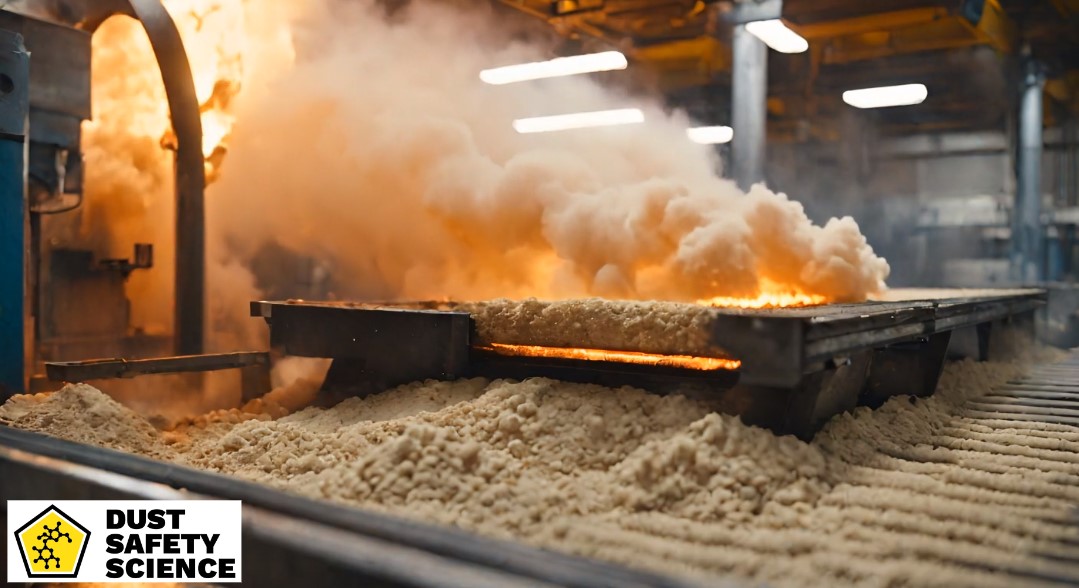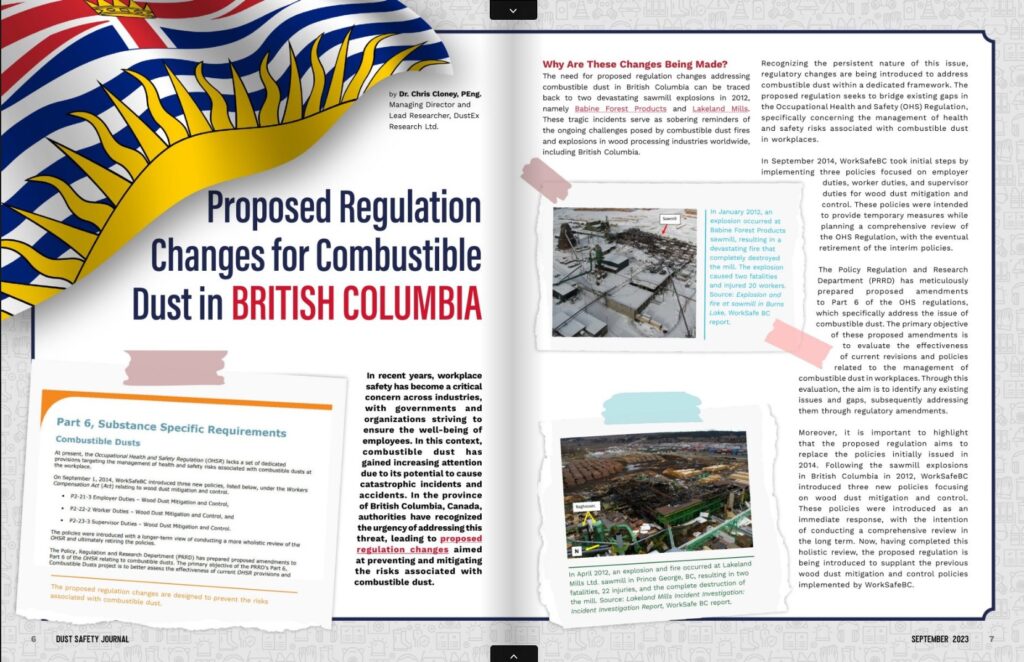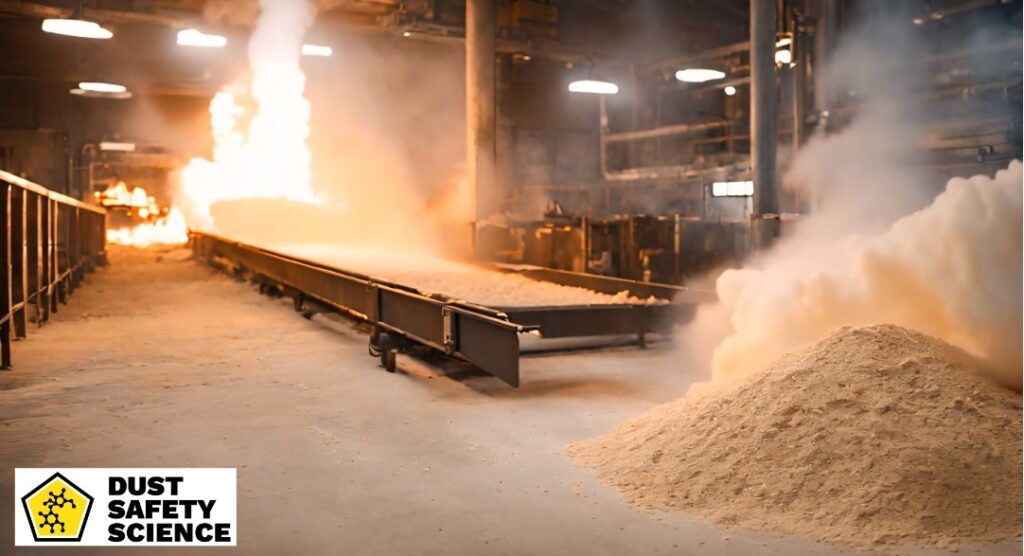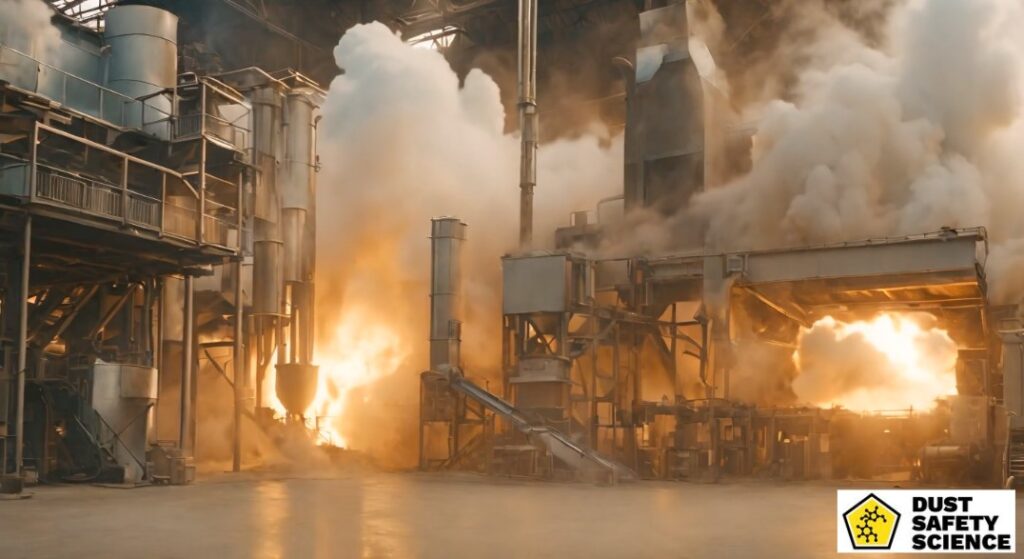Updated December 9, 2024 Authored by Dr. Chris Cloney and Jon Barrett of Dust Safety Science

Introduction of Proposed Amendments of the Combustible Dust Regulations in British Columbia
British Columbia’s Occupational Health and Safety Regulation (OHSR) is undergoing proposed amendments to Part 6, aiming to address emerging concerns and improve existing combustible dust standards. Ensuring workplace safety from combustible dust explosions is paramount for businesses across industries, including wood processing. The proposed amendments to Part 6 of the Occupational Health and Safety Regulation, (OHSR), in British Columbia represent a significant step toward bolstering safety standards and protecting workers’ well-being. This is WorkSafe BC presenting the new Combustible Dust Regulations in British Columbia
At present, the Occupational Health and Safety Regulation (OHSR) needs a set of dedicated provisions targeting the management of health and safety risks associated with combustible dust at the workplace. The three new policies proposed, listed below, under the Workers Compensation Act relating to combustible wood dust mitigation and control:
- P2-21-3 Employer Duties – Wood Dust Mitigation and Control,
- P2-22-2 Worker Duties – Wood Dust Mitigation and Control, and
- P2-23-3 Supervisor Duties – Wood Dust Mitigation and Control.
The policies were introduced with a longer-term view of conducting a more holistic review of the OHSR and ultimately retiring the policies. The Policy, Regulation, and Research Department (PRRD) has prepared proposed amendments to Part 6 of the OHSR relating to dusts and dust accumulation as a fire or explosion hazard.
The primary objective of the PRRD’s Part 6, Dusts project is to assess better the effectiveness of current OHSR provisions and WorkSafeBC policies related to managing combustible dust risks and combustible dust hazards at the workplace, identify issues and gaps therein, and address those by way of regulatory amendments. The proposed amendments aim to provide a more robust and structured regulatory framework governing workplace combustible dust. The PRRD is preparing to release for public consultation these proposed amendments and is requesting feedback. Source: https://www.worksafebc.com/en/resources/law-policy/discussion-papers/consultation-on-proposed-amendments-to-part-6-of-the-occupational-health-and-safety-regulation?lang=en
An Interpretation of the Proposed Changes in British Columbia Combustible Dust Regulations
- Chris Cloney from Dust Safety Science, provides an interpretation of the proposed Part 6, Substance Specific Requirements on Combustible Dust, for the BC Occupational Health and Safety Regulation.
- We’re going to be going through the document and explaining what the different sections are, and how they apply to facilities that are handling potentially combustible dust in British Columbia.
- The start of the document has a little bit of background information on the formation of the regulations starting with the guidelines that were published and the policies that were published previously on combustible wood dust.
- Then the fact that this regulation is going to replace those policies that were previously published. The regulation itself has two pages of definitions, 18 pages of requirements then six pages of explanatory material. The requirements cover the application of the standard and the regulations.

Proposed British Columbia Regulation Document Overview
The proposed amendments to Part 6 of the OHSR outlined by WorkSafeBC encompass various aspects concerning occupational health and safety, with a specific focus on mitigating risks associated with workplace hazards. The proposed regulations outlined by WorkSafeBC, examine insights from industry experts and explore practical examples of how these amendments may impact workplaces. The document emphasizes the importance of enhancing safety measures related to dust, electrical equipment including static electricity, and confined spaces, dust collection system design, among other combustible dust hazards. By understanding the proposed amendments and their implications, businesses can proactively address safety concerns, mitigate risks, and foster a culture of safety within their organizations.
What Is Covered by the Proposed Regulation?
The proposed regulation encompasses a wide range of dust types handled or generated in workplaces, aiming to mitigate the risks associated with combustible dust hazards, comprehensively.
- This includes any dust that is handled or generated in a workplace and other various types of combustible dust such as metal dust, agricultural dust, wood processing, plastic dust, manufactured powders, and lint.
- Dust contained within sealed commercial packaging is excluded from the regulation’s scope.
- It’s important to note that while the proposed regulation is currently undergoing consultation in its draft format, it remains subject to potential changes as feedback and input are considered.

Insights and Key Takeaways from WorkSafeBC Presentation
The presentation by WorkSafeBC provides valuable insights into the rationale behind the proposed amendments and their implications for workplace safety. Through informative sessions and discussions, experts shed light on key issues and offer practical recommendations to address safety concerns effectively, with combustible dust standards, to prevent fires and explosions.
One notable aspect highlighted in the WorkSafeBC presentation is the need for proactive risk assessment and hazard identification. By adopting a proactive approach, employers can identify potential hazards and implement preventive measures to safeguard workers’ well-being. Furthermore, the presentation emphasizes the importance of fostering a culture of safety within organizations. Promoting explosion hazard awareness with a dust hazard analysis, providing comprehensive training, and encouraging active participation in safety initiatives can significantly contribute to creating safer work environments.
Traditionally, regulations about combustible dust and combustible dust materials have been closely associated with industries such as woodworking facilities, sawmills, wood processing, and paper manufacturing, and other industrial facilities where wood particles generate significant amounts of combustible dust. However, as industries evolve and diversify, it has become increasingly evident that managing combustible dust hazards extends far beyond these sectors and requires risk assessments, preventing a fire or explosion hazard.
A significant takeaway from Worksafe BC is that the proposed amendments to Part 6 of the Occupational Health and Safety Regulation, (OHSR), will apply to all industries handling potentially combustible dust, not just wood and wood products, and wood processing.
Numerous industrial facilities, including food processing, pharmaceuticals, metalworking, chemical processing, and textiles, among others, produce combustible particulate solids, hazardous materials, and biological agents, that can produce combustible dust in dust collectors, and can cause fires and explosions. For instance, in the food processing industry, flour, sugar, and spices can generate hazardous dust, while in metalworking, processes like grinding and polishing can produce metal dust particles that pose fire and explosion risks with sulfur fires, dust collectors, and dust collection systems. In addition, flammable gases, and the use of compressed air can cause metal dust clouds and a mixture of hazardous materials, affecting explosion prevention systems, leading to an explosion hazard or dust explosions.

Industry Perspectives and Examples
Industry experts and stakeholders offer valuable perspectives on the proposed amendments and their practical implications for businesses and workers alike. Dust Safety Science also talked about this Introduction of British Columbia’s Occupational Health and Safety Regulation (OHSR), Proposed Amendments to Part 6, and in the Dust Safety Journal
By examining real-life examples and case studies, stakeholders can gain a deeper understanding of how the proposed regulations such as the NFPA combustible dust standards, NFPA 652: Standard Fundamental of Combustible Dust, the Standard Fundamental of Combustible Dust NFPA 654, and the NFPA 660 Standard for Combustible Dust and Particulate Solids Proposed, may impact their operations, work activities, and safety practices. For instance, in the grain handling facilities and woodworking facilities and manufacturing plants, the implementation of robust dust control measures, dust collection systems, and a dust hazard analysis is essential to prevent dust accumulation, hazardous dust incidents, fires and explosions, and ensure worker safety. An employer must not permit the use of blowers, compressed air, dry sweeping or dry mopping to clean up or remove dust. Locating ignition sources, such as static electricity, is essential to dust hazards, and preventing fires and explosions . By investing in state-of-the-art dust collection and dust suppression systems, education and prevention on using compressed air, and adhering to regulatory standards such as the NFPA combustible dust standards, manufacturers can mitigate risks and uphold safety standards.
Similarly, in the construction industry, adherence to electrical equipment safety protocols and electrical safety regulations are paramount to prevent electrocution accidents and ensure worksite safety. Employers must prioritize regular inspections, maintenance, fire protection, dust collection systems, and training to mitigate electrical code hazards effectively. Additional Source:
Timeline in the Regulation Development:
The timeline for the development of regulations is a structured process aimed at ensuring comprehensive input and consideration from stakeholders.
- The initial phase involves public consultation, which concluded in June 2023, allowing for valuable feedback from various stakeholders.
- Subsequently, the Policy and Regulatory Review Division (PRRD) diligently reviews this feedback to understand stakeholders’ perspectives and concerns.
- Following this review, revisions to the proposed regulation are slated to occur, involving collaboration with Legislative Counsel to ensure alignment with legal frameworks and standards.
- This iterative process underscores the commitment to transparency, inclusivity, and legal compliance in the development of regulations and combustible dust standards that prioritize the safety and well-being of workers.
Next Steps in the Regulation Development:
The next steps in the regulation development process involve active engagement with stakeholders and the formalization of the proposed regulations, for consolidating combustible dust standards
- WorkSafeBC is set to hold a public hearing for the updated proposed regulation in the first quarter of 2024, tentatively scheduled as a virtual event. During this hearing, stakeholders will have the opportunity to provide oral feedback with additional information or submit written submissions, ensuring their voices are heard in the regulatory process.
- Following the hearing, WorkSafeBC’s Board of Directors will evaluate the feedback and decide whether to pass the proposed regulation, depending on the nature of subsequent revisions.
- Once passed, the regulation will come into force 90 days after it is deposited, marking a crucial milestone in enhancing safety standards and protecting the well-being of workers.

Conclusion
The proposed amendments to Part 6 of the Occupational Health and Safety Regulation, regarding Combustible Dust in British Columbia, underscore the ongoing commitment to enhancing safety standards, combustible dust standards, ensuring risk assessment, and protecting workers’ well-being. By addressing key areas such as combustible dust safety, dust accumulation, electrical code and electrical equipment standards, electrical installations, dust collection systems, and confined spaces protocol, the proposed regulations aim to mitigate fire hazard risks, and fires and explosions from combustible particulate solids, and promote a culture of safety across various industries.
Through insightful discussions, industry perspectives such as OSHA regulations, and the NFPA combustible dust standards, such as the National Fire Protection Association, NFPA 660, and the National Fire Protection Association, NFPA 61: Standard for the Prevention of Fires and Dust Explosions in Agricultural and Food Products Facilities, along with provincial and federal regulations, and resources provided by WorkSafeBC, stakeholders can gain valuable insights into the potential impact of the proposed Combustible Dust Regulations in British Columbia amendments. In addition, take proactive measures to ensure electrical code compliance and uphold safety standards and combustible dust standards. As the regulatory landscape continues to evolve, with combustible dust standards, collaboration between employers, workers, and regulatory agencies remains essential in fostering safer and healthier work environments for all, from a possible combustible dust explosion.
About Dust Safety Science
Dr. Chris Cloney, of Dust Safety Science, provides additional Combustible Dust information, with a Podcast. Click on this Podcast Link: Introduction of British Columbia’s Occupational Health and Safety Regulation (OHSR), Proposed Amendments to Part 6

Resources:
Visit Dust Safety Science (Global Incident Tracking)
Visit Dust Safety Academy (Resources, Training and Events)
Visit Dust Safety Professionals (Need Help? Get Support Today!)
Visit Dust Safety Journal for the Dust Safety Science Monthly Journal
Subscribe to our Dust Safety Science Newsletter at Dust Safety Science Newsletter
Visit the Dust Safety Science blog for written articles on combustible dust safety including the latest research, expert opinions, and state-of-the art in fire and explosion protection.
